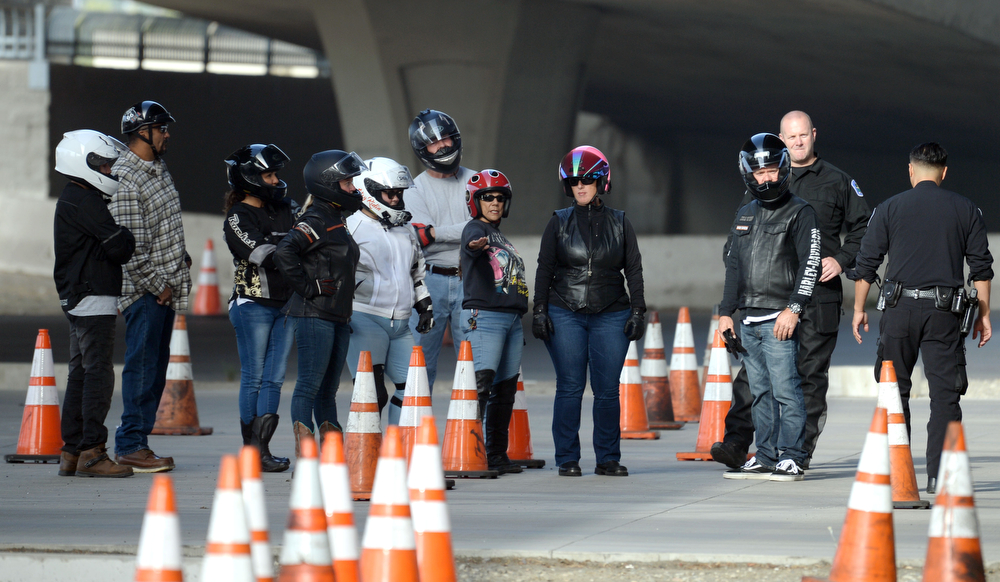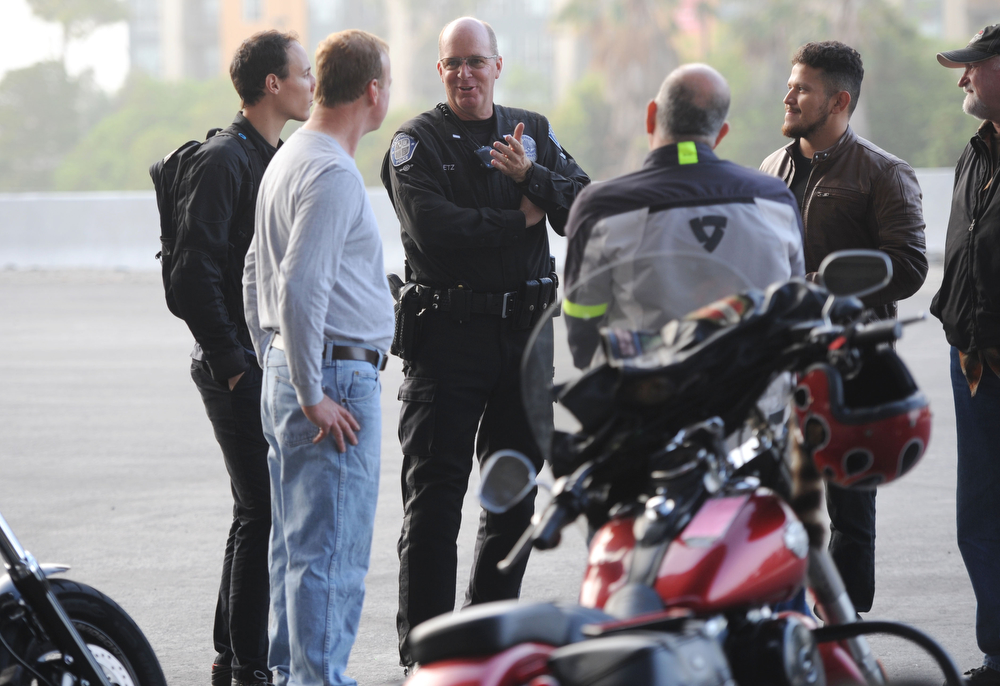It was a cross-county police cooperation effort on a recent Saturday morning, with members of the La Habra Police Department chipping in to help a Hawthorne Police Department class make the streets a bit safer.
La Habra Sgt. Jim Tigner and Officer Sumner Bohee were part of an instruction team for Ride to Live, a free civilian motorcycle skills class organized by Hawthorne police and taught by experienced motorcycle officers. Grant funding from the California Office of Traffic Safety supplemented the class, which also offered participants coffee and doughnuts.

Motorcycle rider Steve Collins of Los Angles during the Ride to Live class in Hawthorne.
Photo by Stephen Carr/ Behind the Badge
Hawthorne has been offering Ride to Live since 2015 and offers classes about 10 times a year. The mission: reduce motorcycle related injuries and deaths.
About 30 eager participants from all over the southland came to Saturday’s session, which took place at a California Department of Transportation property beneath the 405 and 105 freeway interchange and across the street from the Airport Courthouse.
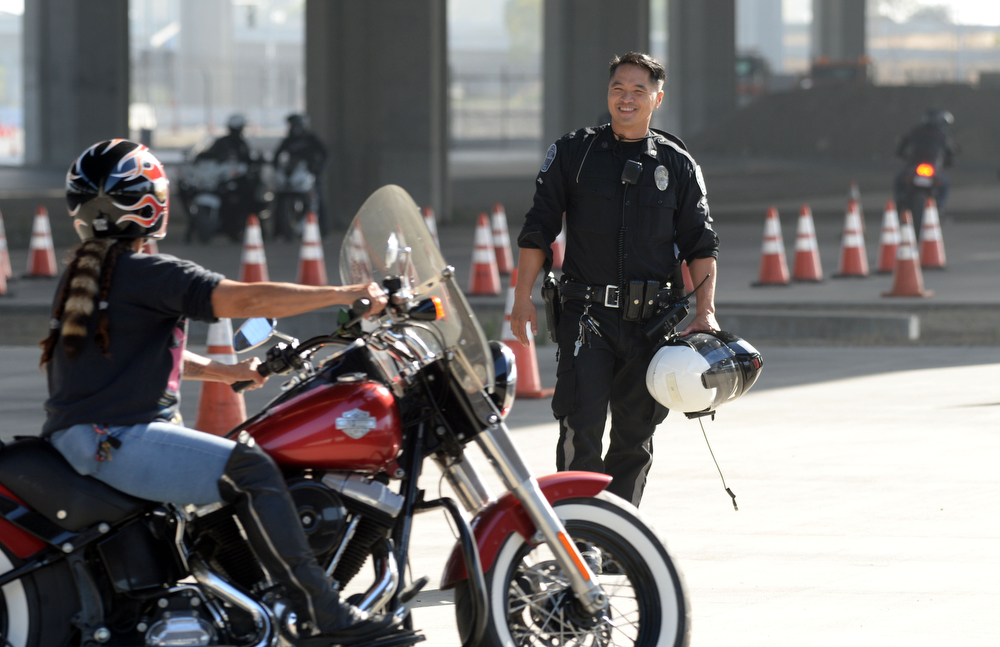
Hawthorne Police Officer Anthony Barlin was all smiles with motorcycle riders during the Ride to Live class, under the 105 freeway. Photo by Stephen Carr/ Behind the Badge
How La Habra came to help Hawthorne’s Ride to Live is a bit of happenstance. A few years ago, Tigner, a department veteran since 1995, was an instructor at the basic motor course in San Bernardino. There he met Ti Goetz, who was in the class. The two have kept in touch ever since.
Bohee met another Hawthorne officer, Anthony Barlin, when they were in basic motor training together. They, too, kept in contact and that professional networking, along with Tigner and Goetz, is what led to La Habra’s helping to instruct in the program.

Kristin Powers of San Diego maneuvers around cones, with Hawthorne Police Officer Anthony Barlin standing by, during the Ride to Live class, under the 105 freeway.
Photo by Stephen Carr/ Behind the Badge
Goetz is a lieutenant with the Hawthorne Police Department. He noted that Ride to Live is now in its 29th class and more than 700 riders have gone through the instruction. The first class started with only five people, Goetz said, and now it’s so popular that spots fill up fast.
The creation of Ride to Live was influenced by two of Hawthorne police’s saddest moments: the losses of Motor Sgt. Leonard Luna in 2013 and Motor Officer Andrew Garton in 2011. Both were killed in the line of duty while on motorcycles.
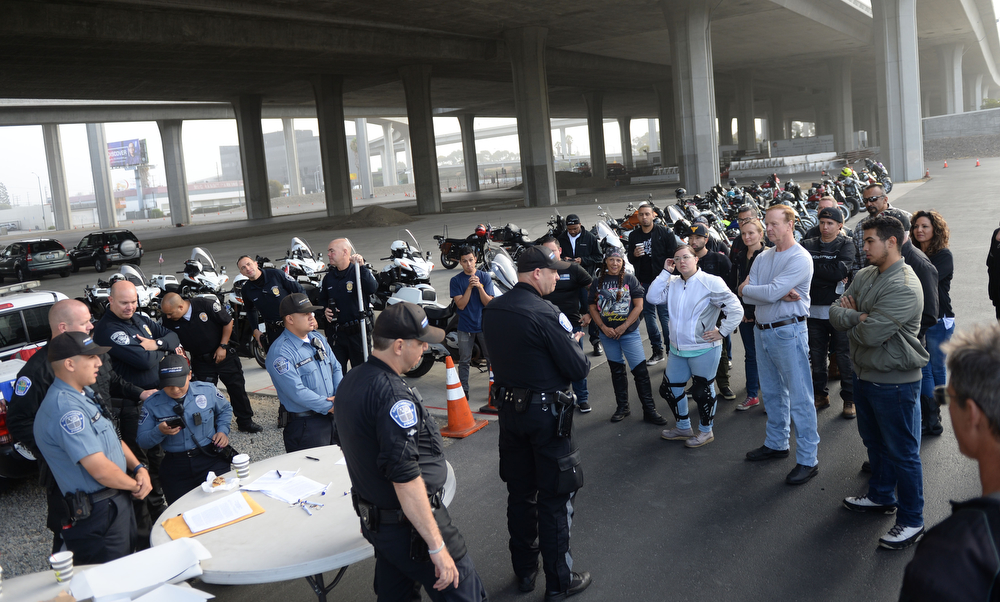
Hawthorne Police Lt. Steve Colquette talks with motorcycle riders before the start of Ride to Live in September 2018.
Photo by Stephen Carr/ Behind the Badge
Tigner noted how motorcycle police training is some of the toughest there is in the law enforcement world. Once certified and on the street, officers spend shifts that can be 12 hours long on their bikes, maneuvering through small spaces, making sharp turns, and avoiding sudden obstacles in their way. They pick up a lot of skills, Tigner said, that the average civilian leisure motorcycle rider doesn’t, especially when considering that officers also are tuned in to radio frequencies to hear and transmit calls. Motor officers must be proficient at multi-tasking all the while be very aware of safety threats.

Motorcycle riders with Motor Officer John Dixon during the Ride to Live class, under the 105 freeway at La Cienega Boulevard.
Photo by Stephen Carr/ Behind the Badge
“I would put our experience up with anybody’s,” Tigner said. “Apart from professional AMA-type riders, I would say we spend the most amount of time practicing and applying our skills on motorcycles. We want to help all riders stay safe and alive by sharing some of our techniques and experiences – both good and bad.”
To sharpen the students’ skills, police set up patterns with traffic cones throughout the Caltrans area. The officers explained how riders can make sharp turns without dropping their feet to the ground, a maneuver to avoid the bike falling down.
“You have to put your head and eyes in the direction of the turn,” Goetz explained.

Officers help right the bike of a motorcycle rider during Ride to Live.
Photo by Stephen Carr/ Behind the Badge
To illustrate the point, the officers stood near the turns and called out to the riders to look up at them. Many riders could; some couldn’t, with their bikes occasionally falling to the ground.
Goetz said even after a few exercises, the students were showing progress.
“They’ll feel so much more confident” by the end of the day, he said, and gain skills that could save theirs or someone else’s life on the road.
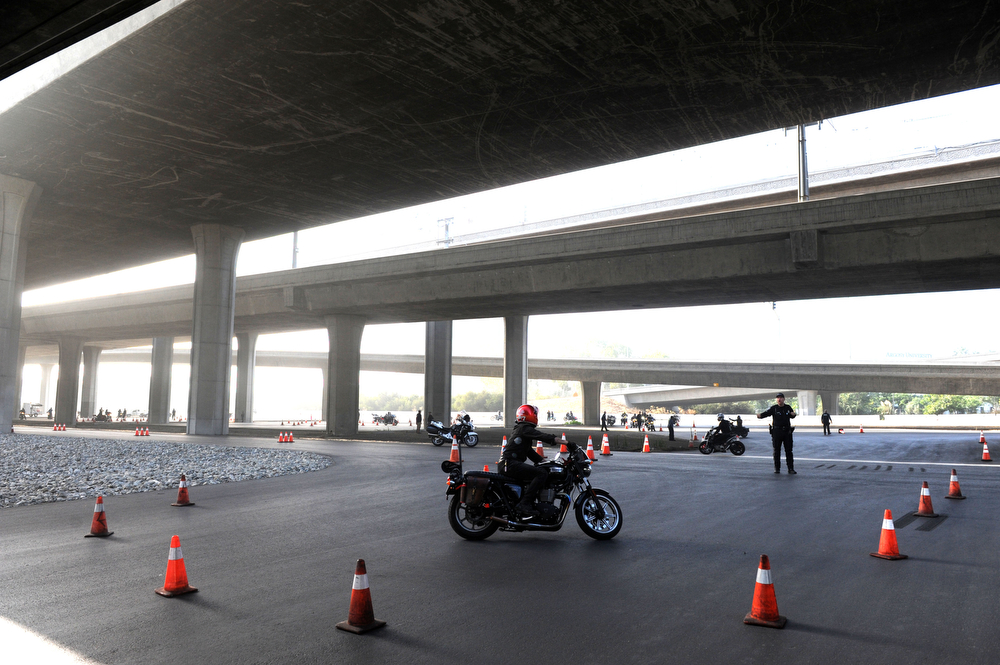
Motorcycle riders practice during the Ride to Live class under the 105 freeway in Hawthorne.
Photo by Stephen Carr/ Behind the Badge
Riding a motorcycle “is so much more than just driving straight,” Goetz said. “You have to be able to handle your bike, be a master of your trade … half of motorcycle riding is a mental game.”
Tigner compared the experience to riding a wild horse – intimidating at first until the rider shows the bike who’s boss.
“Eventually you get to a point where you hop on the horse and you’re in control of the thing,” Tigner explained. “Operating the bike has to become second nature and this takes time and experience.”
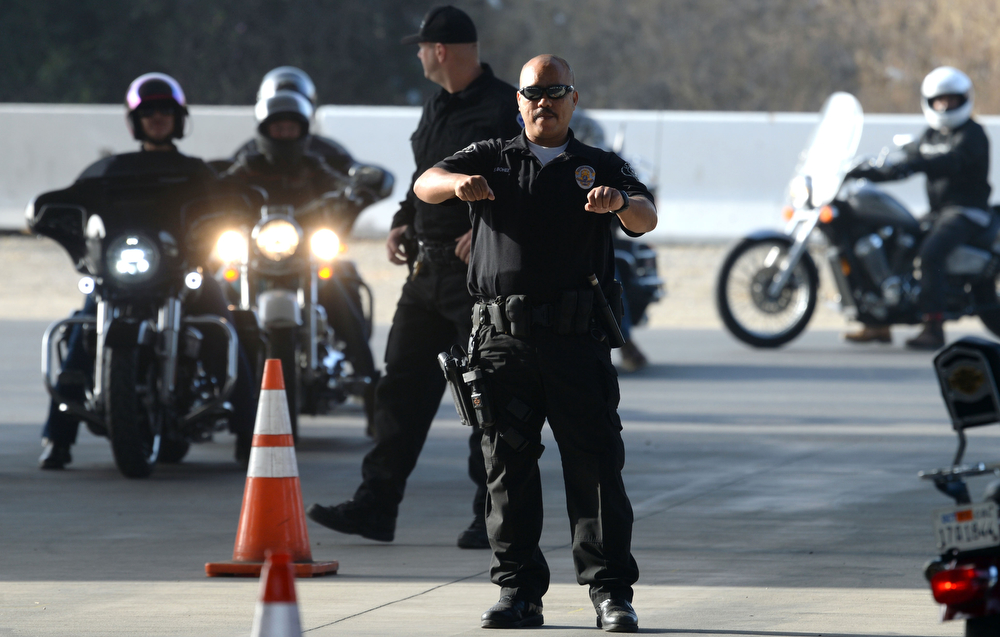
La Habra Police Motor Officer Sumner Bohee works with motorcycle riders during the Ride to Live class.
Photo by Stephen Carr/ Behind the Badge
The students completed slalom patterns, sharp u-turns, and circles. In one exercise, they rode down a hill toward a wall and had to make a quick turn inside the space.
James Cates and Aga Stuchlik came from Laguna Beach. Stuchlik said she was learning to break bad riding habits. “I didn’t even know I had them!” she said. Cates has been riding for 45 years. He said even with those decades riding, he wants to improve his weak areas and is learning new skills.
“He still can’t do the circle!” Stuchlik joked.
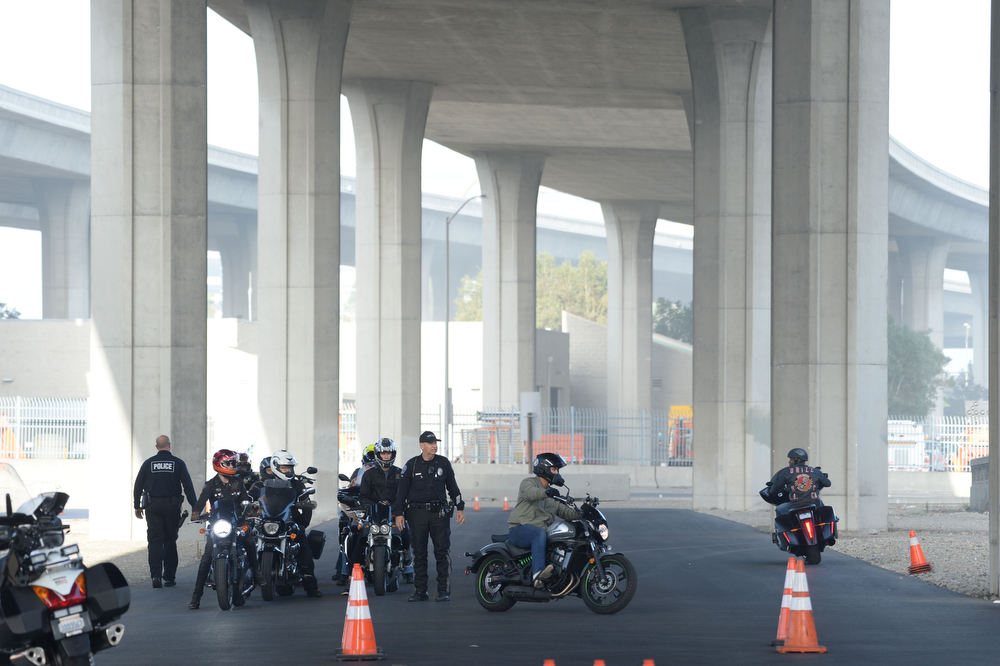
Motorcycle riders learn skills during Ride to Live in Hawthorne.
Photo by Stephen Carr/ Behind the Badge
Kristin Powers came from San Diego for Ride to Live. She loved being taught by the expert officers. She said her confidence was growing, even a few hours into the course.
“Who better to learn from than motor cops?” Powers said excitedly. “It’s amazing.”
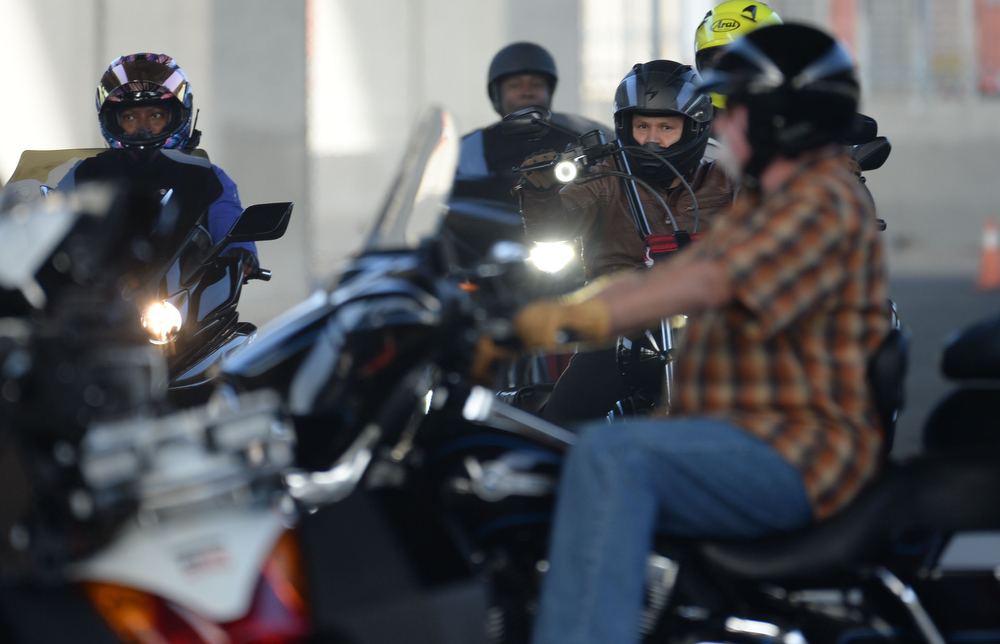
Motorcycle riders are ready to learn during a Ride to Live class in Hawthorne.
Photo by Stephen Carr/ Behind the Badge
If you would like more information, including future available classes, on the Ride to Live program, please go to www.ridetolive.com.
Special thanks to Hawthorne PD and its staff: Lt. Steve Colquette, Lt. Ti Goetz, Officer John Dixon, Officer Sean Judd, and Officer Anthony Barlin.
 Behind the Badge
Behind the Badge

